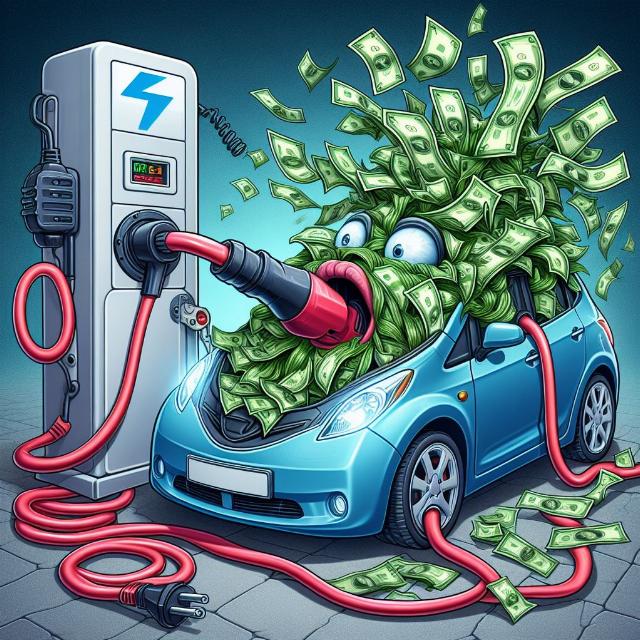EV-maker Fisker is insolvent
In just the last twelve months, how many electric vehicle-related corporate financial disasters have there been? I count no fewer than seven, depending on how meticulous you want to be, so let’s do a quick rundown of recent E.V. woes, not in any particular order or importance (this list is not comprehensive).
💩 First disaster: This is the headliner and hot off the presses, from Stephen Council’s new report at SFGate:
California carmaker Fisker, once worth $2.9 billion, finally goes belly-up
Fisker, an electric vehicle company based in Southern California, has finally declared bankruptcy.
After months of brutal news — a bankruptcy warning, hundreds of layoffs, a massive recall— the La Palma carmaker filed for Chapter 11 protection on Monday. The company, which had already paused the manufacturing of its electric Ocean SUV, will now try to sell its assets.
💩 Second disaster: Lordstown Motors filed for bankruptcy in June last year:
Lordstown Motors, the troubled electric pickup truck company that bought a shuttered General Motors factory in Ohio, filed for bankruptcy protection on Tuesday.
After restructuring, the company reemerged as Nu Ride Inc. in March of this year.
💩 Third disaster: In October of 2023, a Cruise robotaxi struck and drug a pedestrian in San Francisco. In the litigious wake that followed, Cruise grounded its fleet nationwide, lost its CEO Kyle Vogt after he resigned, fired nine other executives and slashed around 25% of its workforce, paid between $8 million and $12 million to the pedestrian in a settlement, agreed to return billions of dollars to shareholders, and faced $1.5 million in fines from the state of California. Last week, parent company GM injected $850 million into Cruise to keep it “afloat” after severe “operational losses” since the incident.
💩 Fourth disaster: Hertz. I’ve written on Hertz a number of times—see here, here, here, and here—but to sum it all up, the company gambled big on transitioning a large portion of its fleet to E.V.s and suffered serious financial losses. Here are some recent numbers, via Yahoo Finance:
The company previously said it would sell off 20,000 EVs from its fleet, meaning it will now dispose of 30,000 EVs in its fleet through the end of 2024. Add today’s charge to the $245 million write-down taken in Q4, and the company has now lost $440 million on its EV gambit.
…
For the quarter, Hertz reported an adjusted loss of $1.28 a share, wider than the $0.44 loss analysts were expecting. Hertz reported an adjusted net income loss of $392 million, more than double the $147 million loss expected.
💩 Fifth disaster: The electric bus company Proterra filed for Chapter 11 bankruptcy protections in August of 2023, after taking more than $8 billion in federal funds, and even having a leg up after the federal government gave Proterra buyers money too! Monica Showalter broke down that whole debacle here.
💩 Sixth disaster: Just two days ago, Yahoo Finance covered the “staggering losses per Ford EV” and reported of the first quarter losses which alone totaled $1.32 billion. Wondering what that figure was per unit? $132,000 per car. There’s more too, because just three days ago, an AutoGuide report revealed this:
Ford Kills Key EV Program
First introduced in September 2022, the program mandated significant investment for dealers to become ‘EV Certified.’ The investment covered the cost of DC fast-chargers and staff training. However, Ford’s initial optimistic EV sales forecasts did not materialize as expected. The growth in the EV market has slowed since 2022, with demand not meeting the projections.
Sales “did not materialize as expected” they say? Au contraire; sales materialized exactly as anyone with a brain and objective perspective anticipated.
💩 Seventh disaster: GM’s E.V. division continues to hemorrhage money, the company only turning a profit thanks to the sales of traditional gas- and diesel-powered vehicles:
GM is on the rise—but for now, EVs are holding it back, not leading the charge
Legacy automaker General Motors reported strong profits Tuesday, despite lagging sales in China and price cuts to some of its models. But beneath the surface, the automaker’s strong financial performance is powered by gas: GM’s quarterly gains were led by its popular SUVs and gas-powered car lines, while producing EVs continues to lose the company money.
…
The strategy that delivered GM’s strong financials represents a departure from the ‘all-in’ EV strategy the company has been pushing for years. GM’s earnings are a win, but underline that the company will have to solve the problem of EV profitability to keep the ball rolling—a hurdle GM representatives say they’re on the verge of clearing.
How many times are they going to reanimate this E.V. corpse?

Image generated by AI.





